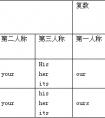句型转换。1. There is a bag on the chair. (改为否定句) There ______ a bag on the chair. 2. There are some bananas on the basket. (改为否定句) There ______ _-七年级英语
6.有些形容词,置于名词之前与之后,含义不尽相同。例如:?
the writer present 出席的作者?
the present writer 现在的作者?
7.表示长,宽,高,深,及年龄的形容词,应放在相应的名词之后。
This river is about 100 metres wide.
The building is more than 50 metres tall.
He is less than 40 years old.
8. enough修饰名词时,在名词前后都可以。
They said that they had enough food.= They said that they had food enough.
enough 修饰形容词和副词,位于其后。
He is old enough to join the army.
He isn’t old enough to go to school.
9.形容词else通常放在疑问代词,疑问副词或不定代词后
what/who/where/when/when else
something/anything/nothing…else
What else did you do?
Do you have anything else to say?
10.由两个或两个以上的词组成的形容词词组修饰名词时须放在名词之后。
This is the book easy to read.
这是一本容易读的书。
名词化的形容词:
有些形容词可以和定冠词连用,表示一类人或事物,这时,它相当于一个名词,可作主语或宾语;
表示一类人时,看作复数,表示一类事物时,通常看作单数。
Robin Hooh(罗宾汉) hated the rich and loved the poor.
The old are taken good care of in American.
the+形容词,常见的短语有:
the old/the young/the sick/the white/
the black/the rich/the poor/the dead(死者)
形似副词的形容词:
以-ly结尾的词通常是副词,但是下列词为形容词。
friendly lonely (孤独的) ;lively (活着的);lovely(可爱的)
复合形容词的类型:
(1)名词+过去分词 man-made satellite 人造卫星
(2)形容词+现在分词 a good-looking man
(3)形容词+名词 second-hand cars
(4)数词+名词-ed three-legged chairs三条腿的椅子
(5)数词+名词 400- metre race
(6)副词+现在分词 hard-working students
(7)副词+过去分词 well-known writers
(8)形容词+形容词 a dark-red jacket
(9)形容词+过去分词 ready-made clothes 成品服装
含有形容词的常用句型:
(1) It’s+adj. of sb. to do sth.
(good/ kind/nice/polite/clever/foolish… )
It’s very kind of you to help me.
(2) It’s +adj. for sb. to do sth.
(difficult/easy/hard/dangerous/usefulinteresting/important…)
It’s important for us to learn English well.
(3)下列形容词后常跟动词不定式
表示情感或情绪的形容词:glad,pleased,sorry,sad,afraid,thankful…
I'm glad to see you.
表示能力,意志或推测的形容词:ready,able,sure,certain…
I’m sorry to hear that.
某些现在分词和过去分词可作形容词
the moving story 令人感动的故事
a moved boy 一个被感动的男孩
a frightened child 一个被吓到的孩子
a frightening film 一个恐怖电影
考点名称:一般疑问句
- 一般疑问句:
是疑问句的一种。通常用yes,no来回答的疑问句叫做一般疑问句。口语中若无特殊含义,句末用升调。
其结构是:系动词be/助动词/情态动词+主语+其他成分?
通常回答为:
肯定:Yes+主语+提问的助动词
否定:No+主语+提问的助动词+not
例如:
Are you from Japan? Yes, I am./No, I'm not.
Do you live near your school? Yes, I do./No, I don't.
Can you speak French? Yes, I can./No, I can't. - 一般疑问句的特性:
1.将陈述句变为一般疑问句时,如句中有be 动词(am/ is/ are)时,可直接将它们提至主语前。
如主语为第一人称,应将其改为第二人称。如:
I'm in Class 2Grade 1. →Are you in Class 2Grade 1﹖
We're watching TV. →Are you watching TV﹖
2.陈述句中有情态动词(can、may、must …)时,也可直接将它们提至主语前,即可成为一般疑问句。如:
He can swim now. →Can he swim now﹖
The children may come with us. → May the children come with us﹖
3.陈述句中只有一个实义动词作谓语且其时态为一般现在时,变为一般疑问句时要在句首加do或does主语后的实义动词用原形。如:
I like these animals. →Do you like these animals﹖
She wants to go to the movies. → Does she want to go to the movies﹖
4.一般疑问句一般读升调(↑)
5.一般疑问句有时不用yes或 no 回答。如:
Are they in town now﹖
I think so.
May I sit here﹖
Certainly.
Does he like soccer﹖
Sorry I don't know.
6. 一般疑问句的第一单词总是虚词,读的时候要读轻声。 - 陈述句变为一般疑问句技巧:
根据一般疑问句不同的家族,可以用不同的方法将陈述句变为相应的一般疑问句。
1、第一家族:含be动词或情态动词的句子
秘诀:一调二改三问号
一调:即把句中的be或情态动词调到主语前;
二改:改换主语称谓,即将句中的主语I\my \mines\we\our\ours等。第一人称分别改为相应的第二人称you\your\ yours等;
三问号:句末的句号改为问号。如:
Eg. I am an English teacher. → Are you an English teacher?
Eg. We can speak English fluently. → Can you speak English fluently?
2、第二家族:含行为动词(或称为实义动词)的句子
秘诀:一加二改三问号
一加:即在句首加助动词Do或Does;
二改:1、把谓语动词改为原形;2、改换主语称谓(同第一家组);
三问号:句末的句号改为问号。
Eg. We read English every morning. → Do you read English every morning?
Eg. Tom’s father listens to English on the radio every evening. →Does Tom’s father listen to English on the radio every evening?
特别注意:对于第二家族一定要注意动词的还原,因为时态与数的变化已经体现在助动词上了。
3、加强记忆口诀:
肯变一,并不难,can 或be提在前;
谓语若为行为动,do 或does句首用。
考点名称:疑问词组
- 疑问词组:
即使由疑问词和一些词一起构成的表示疑问的词组。由how/what与另外一个词组成的词组。
例如:
how many (后接可数名词,多少), how much (后接不可数名词,多少),
how often (表示频率), what if (如果…将会怎么样),
what about (…怎么样), what time (几点) 与how搭配的疑问词组:
How在英语中通常用作副词,是特殊疑问句中本领最大的疑问词。他与其它形容词或副词搭配组成疑问词组
1.How old问年龄、年代。
How old is your friend? 你朋友多大了?
How old is the bridge? 这座桥有多少年代了?
2.How many问可数名词数量。常将可数名词复数紧随其后。如:
How many pictures are there on the wall? 墙上有多少幅画?
How many glasses of milk would you like? 你们想要几杯牛奶?
3.How much询问不可数名词的数量、物品的价格。
How much money is there in the purse? 钱包里有多少钱?
How much are the apples at the moment? 目前苹果什么价钱?
4.How long提问物体的长度、时间的长短。
How long is the Changjia River? 长江有多长?
How long does it take you to do your homework every day?
你每天花多长时间做作业?
5.How soon 对 “in+一段时间 ”提问, 表示“多久之后”。
How soon will you be back? 你多久后回来?
6.How often对表示频率的副词或短语提问。
How often does Mrs. Green go shopping? 格林夫人多久去购一次物?
7.How about用来征求对方意见。
Your father is a worker, how about your mother? 你父亲是工人,你母亲呢?
How about playing games after school this afternoon? 下午放学后做游戏怎么样?
8.How far 问两地间的距离How tall问人(树)的高度;how heavy问重量;how wide问宽;how high可以询问建筑物、山峰高度。
How far is it from the earth to the moon? 从地球到月球有多远?
How tall is Yao Ming? 姚明身高多少?
How heavy is that big box? 那只大箱子有多重?
How wide is the new street? 这条新街有多宽?
How high is the tower in Paris? 巴黎的那座塔有多高?
与what搭配的疑问词组:

![—I want to know if ______ a concert in our school hall this weekend. —Yes. Nancy told me about it. [ ]A. there will have B. there will be C. will there be -九年级英语](http://www.00-edu.com/d/file/ks/4/2/there be juxing/2020-02-28/small8bcf29e494d6f99c2d7c4286c4836a101582899344.jpg)
![There_____ a potato and two tomatoes on the table. [ ]A. isB. areC. hasD. have-七年级英语](http://www.00-edu.com/d/file/ks/4/2/there be juxing/2020-02-28/small596b7df57071a5318d44b4246a8dfcf71582899941.jpg)

![Will there___any schools in the future?[ ]A. isB. areC. amD. be-七年级英语](http://www.00-edu.com/d/file/ks/4/2/there be juxing/2020-02-28/smallfaad594ad286847556f8b2a7bf4e6da41582899915.jpg)
![There is going to _____English movie tonight. [ ]A. be B. be an C. have D. have an -八年级英语](http://www.00-edu.com/d/file/ks/4/2/there be juxing/2020-02-28/small684c03bf16377c6f94e9f828954421a91582899285.jpg)
